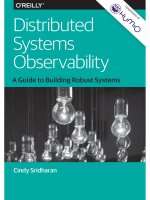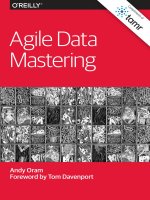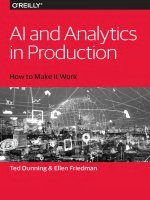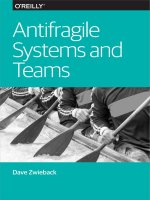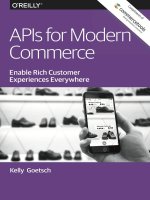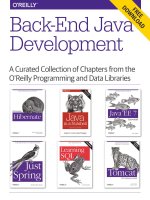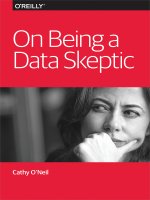IT training streaming architecture mapr ebook khotailieu
Bạn đang xem bản rút gọn của tài liệu. Xem và tải ngay bản đầy đủ của tài liệu tại đây (12.23 MB, 117 trang )
Streaming
Architecture
New Designs Using Apache Kafka
and MapR Streams
Ted Dunning &
Ellen Friedman
Become a Big Data Expert with
Free Hadoop Training
Comprehensive
Hadoop and Spark
On-Demand Training
• Access Curriculum
Anytime, Anywhere
• For Developers, Data Analysts,
& Administrators
• Certifications Available
Start today at mapr.com/hadooptraining
Streaming Architecture
New Designs Using Apache Kafka and
MapR Streams
Ted Dunning and Ellen Friedman
Streaming Architecture
by Ted Dunning and Ellen Friedman
Copyright © 2016 Ted Dunning and Ellen Friedman. All rights reserved.
Printed in the United States of America.
Published by O’Reilly Media, Inc., 1005 Gravenstein Highway North, Sebastopol, CA
95472.
O’Reilly books may be purchased for educational, business, or sales promotional use.
Online editions are also available for most titles (). For
more information, contact our corporate/institutional sales department:
800-998-9938 or
Editors: Holly Bauer and Nicole Tache
March 2016:
Cover Designer: Randy Comer
First Edition
Revision History for the First Edition
2016-03-07: First Release
The O’Reilly logo is a registered trademark of O’Reilly Media, Inc. Streaming Archi‐
tecture, the cover image, and related trade dress are trademarks of O’Reilly Media,
Inc.
While the publisher and the authors have used good faith efforts to ensure that the
information and instructions contained in this work are accurate, the publisher and
the authors disclaim all responsibility for errors or omissions, including without
limitation responsibility for damages resulting from the use of or reliance on this
work. Use of the information and instructions contained in this work is at your own
risk. If any code samples or other technology this work contains or describes is sub‐
ject to open source licenses or the intellectual property rights of others, it is your
responsibility to ensure that your use thereof complies with such licenses and/or
rights.
Images copyright Ellen Friedman unless otherwise specified in the text.
978-1-491-95378-5
[LSI]
Table of Contents
Preface. . . . . . . . . . . . . . . . . . . . . . . . . . . . . . . . . . . . . . . . . . . . . . . . . . . . . . . . v
1. Why Stream?. . . . . . . . . . . . . . . . . . . . . . . . . . . . . . . . . . . . . . . . . . . . . . . 1
Planes, Trains, and Automobiles: Connected Vehicles and
the IoT
Streaming Data: Life As It Happens
Beyond Real Time: More Benefits of Streaming Architecture
Emerging Best Practices for Streaming Architectures
Healthcare Example with Data Streams
Streaming Data as a Central Aspect of Architectural Design
2
5
10
11
13
15
2. Stream-based Architecture. . . . . . . . . . . . . . . . . . . . . . . . . . . . . . . . . . 17
A Limited View: Single Real-Time Application
Key Aspects of a Universal Stream-based Architecture
Importance of the Messaging Technology
Choices for Real-Time Analytics
Comparison of Capabilities for Streaming Analytics
Summary
17
19
22
25
29
31
3. Streaming Architecture: Ideal Platform for Microservices. . . . . . . . . 33
Why Microservices Matter
What Is Needed to Support Microservices
Microservices in More Detail
Designing a Streaming Architecture: Online Video Service
Example
Importance of a Universal Microarchitecture
What’s in a Name?
34
37
38
41
45
46
iii
Why Use Distributed Files and NoSQL Databases?
New Design for the Video Service
Summary: The Converged Platform View
47
47
49
4. Kafka as Streaming Transport. . . . . . . . . . . . . . . . . . . . . . . . . . . . . . . . 51
Motivations for Kafka
Kafka Innovations
Kafka Basic Concepts
The Kafka APIs
Kafka Utility Programs
Kafka Gotchas
Summary
51
52
53
56
63
64
68
5. MapR Streams. . . . . . . . . . . . . . . . . . . . . . . . . . . . . . . . . . . . . . . . . . . . . 69
Innovations in MapR Streams
History and Context of MapR’s Streaming System
How MapR Streams Works
How to Configure MapR Streams
Geo-Distributed Replication
MapR Streams Gotchas
69
71
73
75
77
79
6. Fraud Detection with Streaming Data. . . . . . . . . . . . . . . . . . . . . . . . . 81
Card Velocity
Fast Response Decision to the Question: “Is It Fraud?”
Multiuse Streaming Data
Scaling Up the Fraud Detector
Summary
81
83
85
86
88
7. Geo-Distributed Data Streams. . . . . . . . . . . . . . . . . . . . . . . . . . . . . . . . 89
Stakeholders
Design Goals
Design Choices
Advantages of Streams-based Geo-Replication
90
91
92
96
8. Putting It All Together. . . . . . . . . . . . . . . . . . . . . . . . . . . . . . . . . . . . . . 97
Benefits of Stream-based Architectures
Making the Transition to Streaming Architecture
Conclusion
98
99
103
A. Additional Resources. . . . . . . . . . . . . . . . . . . . . . . . . . . . . . . . . . . . . . . 105
iv
|
Table of Contents
Preface
The ability to handle and process continuous streams of data pro‐
vides a considerable competitive edge. As a result, being able to take
advantage of streaming data is beginning to be seen as an essential
part of building a data-driven organization.
The expanding use of streaming data raises the question of how best
to design systems to handle it effectively, from the ingestion from
multiple sources, through a variety of uses, including streaming ana‐
lytics and the question of persistence.
Emerging best practices for the design of streaming architectures
may surprise you—the scope of powerful design for streaming sys‐
tems extends far beyond specific real-time or near–real time appli‐
cations. New approaches to streaming designs can greatly improve
the efficiency of your overall organization.
Who Should Use This Book
If you already use streaming data and want to design an architecture
for best performance, or if you are just starting to explore the value
of streaming data, this book should be helpful. You’ll also find realworld use cases that help you see how to put these approaches to
work in several different settings. For developers, you’ll also find
links to sample programs.
This book is designed for both nontechnical and technical audien‐
ces, including business analysts, architects, team leaders, data scien‐
tists, and developers.
v
What Is Covered
In this book, we:
• Explain how to recognize opportunities where streaming data
may be useful
• Show how to design streaming architecture for best results in a
multiuser system
• Describe why particular capabilities should be present in the
message-passing layer to take advantage of this type of design
• Explain why stream-based architectures are helpful to support
microservices
• Describe particular tools for messaging and streaming analytics
that best fit the requirements of a strong stream-based design.
Chapters 1–3 explain the basic aspects of strong architecture for
streaming and microservices. If you are already familiar with many
business goals for streaming data, you may want to start with Chap‐
ter 2, in which we describe the type of architecture that we recom‐
mend for streaming systems.
In addition to explaining the capabilities needed to support this
emerging best practice, we also describe some of the currently avail‐
able technologies that meet these requirements well. Chapter 4 goes
into some detail on Apache Kafka, including links to sample pro‐
grams provided by the authors. Chapter 5 describes another prefer‐
red technology for effective message passing known as MapR
Streams, which uses the Apache Kafka API but with some additional
capabilities.
Later chapters provide a deeper dive into real-world use cases that
employ streaming data as well as a look forward to how this exciting
field is likely to evolve.
Conventions Used in This Book
This icon indicates a general note.
vi
|
Preface
This icon signifies a tip or suggestion.
This icon indicates a warning or caution.
Preface
|
vii
CHAPTER 1
Why Stream?
Life doesn’t happen in batches.
Many of the systems we want to monitor and to understand happen
as a continuous stream of events—heartbeats, ocean currents,
machine metrics, GPS signals. The list, like the events, is essentially
endless. It’s natural, then, to want to collect and analyze information
from these events as a stream of data. Even analysis of sporadic
events such as website traffic can benefit from a streaming data
approach.
There are many potential advantages of handling data as streams,
but until recently this method was somewhat difficult to do well.
Streaming data and real-time analytics formed a fairly specialized
undertaking rather than a widespread approach. Why, then, is there
now an explosion of interest in streaming?
The short answer to that question is that superb new technologies
are now available to handle streaming data at high-performance lev‐
els and at large scale—and that is leading more organizations to
handle data as a stream. The improvements in these technologies are
not subtle. Extremely high performance at scale is one of the chief
advances, though not the only one. Previous rates of message
throughput for persistent message queues were in the range of thou‐
sands of messages per second. The new technologies we discuss in
this book can deliver rates of millions of messages per second, even
while persisting the messages. These systems can be scaled horizon‐
tally to achieve even higher rates, and improved performance at
1
scale isn’t the only benefit you can get from modern streaming sys‐
tems.
The upshot of these changes is that getting real-time insights from
streaming data has gone from promise to widespread practice. As it
turns out, stream-based architectures additionally provide funda‐
mental and powerful benefits.
Streaming data is not just for highly specialized
projects. Stream-based computing is becoming
the norm for data-driven organizations.
New technologies and architectural designs let you build flexible
systems that are not only more efficient and easier to build, but that
also better model the way business processes take place. This is true
in part because the new systems decouple dependencies between
processes that deliver data and processes that make use of data. Data
from many sources can be streamed into a modern data platform
and used by a variety of consumers almost immediately or at a later
time as needed. The possibilities are intriguing.
We will explain why this broader view of streaming architecture is
valuable, but first we take a look at how people use streaming data,
now or in the very near future. One of the foremost sources of con‐
tinuous data is from sensors in the Internet of Things (IoT), and a
rapidly evolving sector in IoT is the development of futuristic “con‐
nected vehicles.”
Planes, Trains, and Automobiles: Connected
Vehicles and the IoT
In the case of the modern and near-future personal automobile, it
will likely be exchanging information with several different audien‐
ces. These may include the driver, the manufacturer, the telematics
provider, in some cases the insurance company, the car itself, and
soon, other cars on the road.
Connected cars are one of the fastest-changing specialties in the IoT
connected vehicles arena, but the idea is not entirely new. One of the
earliest connected vehicles—a distant harbinger of today’s designs—
came to the public’s attention in the early 1970s. It was NASA’s
2
|
Chapter 1: Why Stream?
Lunar Roving Vehicle (LRV), shown in action on the moon in the
images of Figure 1-1.
At a time when drivers on Earth navigated using paper road maps
(assuming they could successfully unfold and refold them) and
checked their oil, coolant, and tire pressure levels manually, the
astronaut drivers of the LRV navigated on the moon by continu‐
ously sending data on direction and distance to a computer that cal‐
culated all-important insights needed for the mission. These
included overall direction and distance back to the Lunar Module
that would carry them home. This “connected car” could talk to
Earth via audio or video transmissions. Operators at Mission Con‐
trol were able to activate and direct the video camera on the LRV
from their position on Earth, about a quarter million miles away.
Figure 1-1. Top: US NASA astronaut and mission commander Eugene
A. Cernan performs a check on the LRV while on the surface of the
moon during the Apollo 17 mission in 1972. The vehicle is stripped
down in this photo prior to being loaded up for its mission. (Image
Planes, Trains, and Automobiles: Connected Vehicles and the IoT
|
3
credit: NASA/astronaut Harrison H. Schmitt; in the public domain:
Bottom: A fully equipped LRV on the moon
during the Apollo 15 mission in 1971. This is a connected vehicle with
a low-gain antenna for audio and a high-gain antenna to transmit
video data back to Mission Control on Earth. (Image credit: NASA/
Dave Scott; cropped by User:Bubba73; in the public domain: http://
bit.ly/lvr-apollo15.)
Vehicle connectivity for Earth-bound cars has come a long way
since the Apollo missions. Surprisingly, among the most requested
services that automobile drivers want from their connectivity is to
listen to their own music playlist or to more easily use their cell
phone while they are driving—it’s almost as though they want a cell
phone on wheels. Other desired services for connected cars include
being able to get software updates from the car manufacturer, such
as an update to make warning signals operate correctly. Newer car
models make use of environmental data for real-time adjustments in
traction or steering. Data about the car’s function can be used for
predictive maintenance or to alert insurance companies about the
driver and vehicle performance. (As of the date of writing this book,
modern connected cars do not communicate with anyone on the
moon, although they readily make use of 4G networks.)
Today’s cars are also equipped with an event data recorder (EDR),
also called a “black box,” such as that well-known device on air‐
planes. Huge volumes of sensor data for a wide variety of parameters
are collected and stored, mainly intended to be used in case of an
accident or malfunction.
Connectivity is particularly important for high-performance auto‐
mobiles. Formula I racecars are connected cars. Modern Formula I
cars measure hundreds of sensors at up to 1 kHz (or even more with
the latest technology) and transmit the data back to the pits via an
RF link for analysis and forwarding back to headquarters.
Cars are not the only IoT-enabled vehicles. Trains, planes, and ships
also make use of sensor data, GPS tracking, and more. For example,
partnerships between British Railways, Cisco Systems, and telecom‐
munication companies are building connected systems to reduce
risk for British trains. Heavily equipped with sensors, the trains
monitor the tracks, and the tracks monitor the trains while also
communicating with operating centers. Data such as information
about train speed, location, and function as well as track conditions
4
|
Chapter 1: Why Stream?
are transmitted as continuous streams of data that make it possible
for computer applications to provide low-latency insights as events
happen. In this way, engineers are able to take action in a timely
manner.
These examples underline one of the main benefits of real-time
analysis of streaming data: the ability to respond quickly to events.
Streaming Data: Life As It Happens
The benefits of handling streaming data well are not limited to get‐
ting in-the-moment actionable insights, but that is one of the most
widely recognized goals. There are many situations where in order
for a response to be of value, it needs to happen quickly. Take for
instance the situation of crowd-sourced navigation and traffic
updates provided by the mobile application known as Waze. A view
of this application is shown in Figure 1-2. Using real-time streaming
input from millions of drivers, Waze reports current traffic and road
information. These moment-to-moment insights allow drivers to
make informed decisions about their route that can reduce gasoline
usage, travel time, and aggravation.
Streaming Data: Life As It Happens
|
5
Figure 1-2. Display of a smartphone application known as Waze. In
addition to providing point-to-point directions, it also adds value by
supplying real-time traffic information shared by millions of drivers.
Knowing that there is a slow-down caused by an accident on a par‐
ticular freeway during the morning commute is useful to a driver
while the incident and its effect on traffic are happening. Knowing
about this an hour after the event or at the end of the day, in con‐
trast, has much less value, except perhaps as a way to review the his‐
tory of traffic patterns. But these after-the-fact insights do little to
help the morning commuter get to work faster. Waze is just one
straightforward example of the time-value of information: the value
of that particular knowledge decreases quickly with elapsed time.
Being able to process streaming data via a 4G network and deliver
6
|
Chapter 1: Why Stream?
reports to drivers in a timely manner is essential for this navigation
tool to work as it is intended.
Low-latency analysis of streaming data lets you
respond to life as it happens.
Time-value of information is significant in many use cases where the
value of particular insights diminishes very quickly after the event.
The following section touches on a few more examples.
Where Streaming Matters
Let’s start with retail marketing. Consider the opportunities for
improving customer experience and raising a customer’s tendency
to buy something as they pass through a brick-and-mortar store.
Perhaps the customer would be encouraged by a discount coupon,
particularly if it were for an item or service that really appealed to
them.
The idea of encouraging sales through coupons is certainly not new,
but think of the evolution in style and effectiveness of how this mar‐
keting technique can be applied. In the somewhat distant past, dis‐
count coupons were mailed en masse to the public, with only very
rough targeting in terms of large areas of population—very much a
fire hose approach. Improvements were made when coupons were
offered to a more selective mailing list based on other information
about a customer’s interests or activities. But even if the coupon was
well-matched to the customer’s interest, there was a large gap in
time and focus between receiving it via mail or newspaper and being
able to act on it by going to the store. That left plenty of time for the
impact of the coupon to “wear off ” as the customer became distrac‐
ted by other issues, making even this targeted approach fairly hit-ormiss.
Now imagine instead that as a customer passes through a store, a
display sign lights up as they pass to offer a nice selection of colors
in a specific style of sweater or handbag that interests them. Perhaps
a discount coupon code shows up on the customer’s phone as they
reach the electronics department. Or suppose the store is an out‐
door outfitter that can distinguish customers who are interested in
Streaming Data: Life As It Happens
|
7
camping plus canoeing from those who like camping plus mountain
biking, based on their past purchases or web-viewing habits. Bea‐
cons might react to the smartphones of customers as they enter and
provide offers via text messages to their phones that fit these differ‐
ent tastes. How much more effective could a discount coupon be if
it’s offered not only to the right person but also at just the right
moment?
These new approaches to customer-responsive, in-the-moment
marketing are already being implemented by some large retail mer‐
chants, in some cases developed in-house and in others through
vendors who provide innovative new services. The ability to recog‐
nize the presence of a particular customer may make use of a WiFi
connection to a cell phone or sometimes via beacons placed strategi‐
cally in a store. These techniques are not limited to retail stores.
Hotels and other service organizations are also beginning to look at
how these approaches can help them better recognize return cus‐
tomers or be alert to constantly changing levels needed for service at
check-in or in the hotel lounge.
These approaches are not limited to retail marketing. Surprisingly,
similar techniques can also be used to track the position of garbage
trucks and how they service “smart” dumpsters that announce their
relative fill levels. Trucks can be deployed on customized schedules
that better match actual needs, thus optimizing operations with
regard to drivers’ time, gas consumption, and equipment usage.
The main goal in each of these sample situations is to gain actiona‐
ble insights in a timely manner. The response to these insights may
be made by humans or may be automated processes. Either way,
timing is the key. The aim is to exploit streaming data and new tech‐
nologies to be able to respond to life in the moment. But as it turns
out, that’s not the only advantage to be gained from using streaming
data, as we discuss later in this chapter. It turns out that a streaming
architecture forms the core for a wide-ranging set of processes,
some of which you may not previously have thought of in terms of
streaming.
One of the most important and widespread situations in which it is
important to be able to carry out low-latency analytics on streaming
data is for defending data security. With a well-designed project, it is
possible to monitor a large variety of things that take place in a sys‐
tem. These actions might include the transactions involving a credit
8
|
Chapter 1: Why Stream?
card or the sequence of events related to logins for a banking web‐
site. With anomaly detection techniques and very low-latency tech‐
nologies, cyber attacks by humans or robots may be discovered
quickly so that action can be taken to thwart the intrusion or at least
to mitigate loss.
Batch Versus Streaming
In the past, in order to handle data analysis at scale, data was collec‐
ted and analyzed in batch. What’s the difference in a batch versus a
streaming process? Consider for a moment this simple analogy:
compare data to water that may be collected in a bucket and deliv‐
ered to the user versus water that flows to the user via a pipe.
It’s possible to put a valve on the pipe such that the flow of water is
periodically interrupted when the tap is closed. But with the pipe
and valve, it is the choice of the user whether to hold back the water
or to let it flow—it can handle both styles of delivery. In contrast,
even if you carry buckets very quickly to the recipient, the water
delivered by bucket (batch) will never occur as a continuous stream.
In computing, batch processing is a good way to deal with huge
amounts of distributed data, and batch-based computational
approaches such as MapReduce or Spark are still useful in many sit‐
uations. If you require an hourly summation of a series of events
and an end-of-day or weekly final sum, batch processes may serve
your needs well. But for many use cases, batch does not sufficiently
reflect the way life happens. That observation underlies the increas‐
ing interest in flow-based computing, which is explained more
thoroughly in Chapter 3.
As mentioned earlier, the benefits of adopting a streaming style of
handling data go far beyond the opportunity to carry out real-time
or near–real time analytics, as powerful as those immediate insights
may be. Some of the broader advantages require durability: you
need a message-passing system that persists the event stream data in
such a way that you can apply checkpoints to let you restart reading
from a specific point in the flow.
Streaming Data: Life As It Happens
|
9
Beyond Real Time: More Benefits of
Streaming Architecture
Industrial settings provide examples from the IoT where streaming
data is of value in a variety of ways. Equipment such as pumps or
turbines are now loaded with sensors providing a continuous stream
of event data and measurements of many parameters in real or nearreal time, and many new technologies and services are being devel‐
oped to collect, transport, analyze, and store this flood of IoT data.
Modern manufacturing is undergoing its own revolution, with an
emphasis on greater flexibility and the ability to more quickly
respond to data-driven decisions and reconfigure to make appropri‐
ate changes to products or processes. Design, engineering, and pro‐
duction teams are to work much more closely together in future.
Some of these innovative approaches are evident in the worldleading work of the University of Sheffield Advanced Manufacturing
Centre with Boeing (AMRC) in northern England. A fully reconfig‐
urable futuristic Factory 2050 is scheduled to open there in 2016. It
is designed to enable production pods from different companies to
“dock” on the factory’s circular structure for additional customiza‐
tion. This facility is depicted in Figure 1-3.
Figure 1-3. Hub-and-spoke design of the fully reconfigurable Factory
2050, a revolutionary facility that is part of the AMRC. Its flexible
interior layout will enable rapid changes in product design, a new style
10
|
Chapter 1: Why Stream?
in how manufacturing is done. (Image credit Bond Bryan Architects,
used with permission.)
This move toward flexibility in manufacturing as part of the IoT is
also reflected in the now widespread production of so-called “smart
parts.” The idea is that not only will sensor measurements on the
factory floor during manufacture provide a fine-grained view of the
manufacturing process, the parts being produced will also report
back to the manufacturer after they are deployed to the field. This
data informs the manufacturer of how well the part performs over
its lifetime, which in turn can influence changes in design or manu‐
facture. Additionally, these streams of smart-part reports are also a
monetizable product themselves. Manufacturers may sell services
that draw insights from this data or in some cases sell or license
access to the data itself. What all this means is that streaming data is
an essential part of the success of the IoT at many levels.
The value of streaming sensor data goes beyond real-time insights.
Consider what happens when sensor data is examined along with
long-term detailed maintenance histories for parts used in pumps or
other industrial equipment. The event stream for the sensor data
now acts as a “time machine” that lets you look back, with the help
of machine learning models, to find anomalous patterns in meas‐
urement values prior to a failure. Combined with information from
the parts’ maintenance histories, potential failures can be noted long
before the event, making predictive maintenance alerts possible
before catastrophic failures can occur. This approach not only saves
money; in some cases, it may save lives.
Emerging Best Practices for Streaming
Architectures
An old way of thinking about streaming data is “use it and lose it.”
This approach assumed you would have an application for real-time
analytics, such as a way to process information from the stream to
create updates to a real-time dashboard, and then just discard the
data. In cases where an upstream queuing system for messages was
used, it was perhaps thought of only as a safety buffer to temporarily
hold event data as it was ingested, serving as a short-term insurance
against an interruption in the analytics application that was using
the data stream. The idea was that the data in the event stream no
Emerging Best Practices for Streaming Architectures
|
11
longer had value beyond the real-time analytics or that there was no
easy or affordable way to persist it, but that’s changing.
While queuing is useful as a safety message, with the right messag‐
ing technology, it can serve as so much more. One thing that needs
to change to gain the full benefit of streaming data is to discard the
“use it and lose it” style of thinking.
When it comes to streaming data, don’t just use
it and throw it away. Persistence of data streams
has real benefits.
Being able to respond to life as it happens is a powerful advantage,
and streaming systems can make that possible. For that to work effi‐
ciently, and in order to take advantage of the other benefits of a welldesigned streaming system, it’s necessary to look at more than just
the computational frameworks and algorithms developed for realtime analytics. There has been a lot of excitement in recent years
about low-latency in-memory frameworks, and understandably so.
These stream processing analytics technologies are extremely
important, and there are some excellent new tools now available, as
we discuss in Chapter 2. However, for these to be used effectively
you also need to have access to the appropriate data—you need to
collect and transport data as streams. In the past, that was not a
widespread practice. Now, however, that situation is changing and
changing fast.
One of the reasons modern systems can now more easily handle
streaming data is improvements in the way message-passing systems
work. Highly effective messaging technologies collect streaming
data from many sources—sometimes hundreds, thousands, or even
millions—and deliver it to multiple consumers of the data, including
but not limited to real-time applications. You need the effective
message-passing capabilities as a fundamental aspect of your
streaming infrastructure.
12
|
Chapter 1: Why Stream?
At the heart of modern streaming architecture
design style is a messaging capability that uses
many sources of streaming data and makes it
available on demand by multiple consumers. An
effective message-passing technology decouples
the sources and consumers, which is a key to
agility.
Healthcare Example with Data Streams
Healthcare provides a good example of the way multiple consumers
might want to use the same data stream at different times. Figure 1-4
is a diagram showing several different ways that a stream of test
results data might be used. In our healthcare example, there are
multiple data sources coming from medical tests such as EKGs,
blood panels, or MRI machines that feed in a stream of test results.
Our stream of medical results is being handled by a modern-style
messaging technology, depicted in the figure as a horizontal tube.
The stream of medical test results data would not only include test
outcomes, but also patient ID, test ID, and possibly equipment ID
for the instrumentation used in the lab tests.
With streaming data, what may come to mind first is real-time ana‐
lytics, so we have shown one consumer of the stream (labeled “A” in
the figure) as a real-time application. In the older style of working
with streaming data, the data might have been single-purpose: read
by the real-time application and then discarded. But with the new
design of streaming architecture, multiple consumers might make
use of this data right away, in addition to the real-time analytics pro‐
gram. For example, group “B” consumers could include a database
of patient electronic medical records and a database or search docu‐
ment for number of tests run with particular equipment (facilities
management).
Healthcare Example with Data Streams
|
13
Figure 1-4. Healthcare example with streaming data used for more
than just real-time analytics. The diagram shows a schematic design
for a system that handles data from several sources such that it can be
used in different ways and at different times by multiple consumers.
The message-passing technology is represented here by the tube labeled
with the content of the data stream (medical test results). EMR stands
for electronic medical records. Note that the consumer in group C, the
insurance audit, might not have been planned for when the system was
designed or deployed.
One of the interesting aspects of this example is that we may want
the data stream to serve as a durable, auditable record of the test
14
|
Chapter 1: Why Stream?
results for several purposes, such as an insurance audit (labeled as
use type “C” in the figure). This audit could happen at a later time
and might even be unplanned. This is not a problem if the messag‐
ing software has the needed capabilities to support a durable, replay‐
able record.
Streaming Data as a Central Aspect of
Architectural Design
In this book, we explore the value of streaming data, explain why
and how you can put it to good use, and suggest emerging best prac‐
tices in the design of streaming architectures. The key ideas to keep
in mind about building an effective system that exploits streaming
data are the following:
1. Real-time analysis of streaming data can empower you to react
to events and insights as they happen.
2. Streaming data does not need to be discarded: data persistence
pays off in a variety of ways.
3. With the right technologies, it’s possible to replicate streaming
data to geo-distributed data centers.
4. An effective message-passing system is much more than a
queue for a real-time application: it is the heart of an effective
design for an overall big data architecture.
The latter three points (persistence of streaming data, geodistributed replication, and the central importance of the correct
messaging layer) are relatively new aspects of the preferred design
for streaming architectures. Perhaps the most disruptive idea pre‐
sented here is that streaming architecture should not be limited to
specialized real-time applications. Instead, organizations benefit by
adopting this streaming approach as an essential aspect of efficient,
overall architecture.
Streaming Data as a Central Aspect of Architectural Design
|
15

